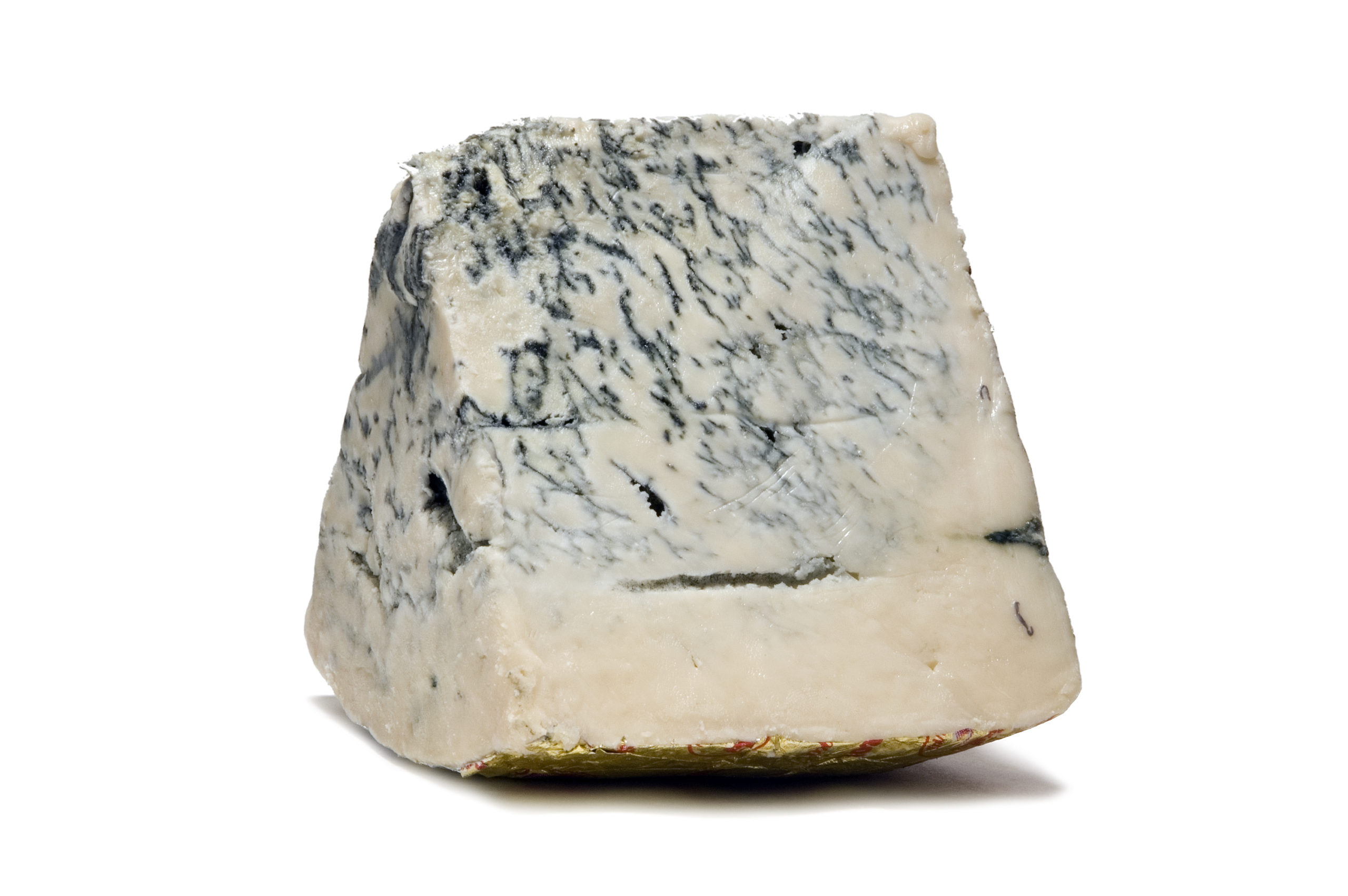
Photographed by Will Edwards
Centuries ago, blue cheeses were probably all mistakes. “It doesn’t matter whether it’s the Roquefort story, the Gorgonzola story, or even Stilton, they were all about cracks and defects,” says Neville McNaughton, an international cheesemaking consultant based in Missouri. In the days before cheesemakers fully understood the microbiology of their craft, if a cheese rind cracked or didn’t form properly then air would enter the wheel, activating molds that needed oxygen to grow. McNaughton believes that Stilton, England’s famous blue, probably descends from cheddar breached in this way.
Modern cheesemakers prefer consistency and control, so they inoculate the milk or curds with the mold of their choosing, usually some strain of Penicillium roqueforti. The mold slumbers for days or even weeks until the young wheel is pierced, typically with mechanical needles. Provided with oxygen, the mold kicks into gear and begins proliferating in the channels left by the needles and in any other pockets of air. Inspect the outside of a wheel of blue cheese and you may still see the evenly spaced needle marks.
Generally speaking, the more veining in a blue cheese, the more piquant it will be. The interior of Spanish Cabrales can be almost overrun with blueing, due to months of aging in humid natural caves. One look at that well-marbled paste and you know to expect a peppery bite. Cheeses with less extensive veining, such as Ireland’s Cashel Blue or Spain’s La Peral, tend to pack less punch. Through their choice of cultures and the aging conditions they provide, cheesemakers influence the eventual degree of sharpness.
Blue cheeses might strike you as more salty than other types; This is because salt helps keep the aggressive P. roqueforti mold in check, to prevent it from breaking down a wheel’s paste, or interior, too quickly. An undersalted blue “will have no keeping quality at all,” says McNaughton. The task for the cheesemaker is to make a wheel with balanced flavor, so that the cheese seems well seasoned but not too salty. Notice, also, that blue veining rarely extends right up to the rind; that’s because the salt concentration is highest near the surface.
Although blue cheeses can theoretically be made with any type of milk, the preponderance are cow’s milk cheeses. Fans of sheep’s milk cheese have increasingly varied options besides Roquefort and Bleu des Basques, including the rare Beenleigh Blue from the south of England and Crozier Blue from Ireland. American Cheese Society judges have awarded ribbons to a handful of domestic sheep’s milk blues in recent years, including Ewe’s Blue from Old Chatham Creamery in New York, Little Boy Blue from Hook’s Cheese Company, Inc. in Wisconsin, and Big Woods Blue from Shepherd’s Way Farm in Minnesota.
Blue cheeses from goat’s milk are scarcer, for reasons that probably have more to do with local tradition and farm economies than any technical barriers. In the world of cheese, speculates McNaughton, blue cheeses are luxury goods that take time, painstaking attention, and controlled conditions to perfect. Goat cheeses, historically, have been sustenance products, made on small farms and sold quickly for cash flow. The hard-to-get Harbourne Blue, a small-production cheese from England, proves that goat’s milk can produce an exquisite blue wheel. A few newer entries from domestic producers—such as Hopelessly Bleu from Pure Luck Farm and Dairy in Texas, Cayuga Blue from Lively Run Goat Dairy in New York, and Echo Mountain Blue, a goat/cow blend from Oregon’s Rogue Creamery—suggest that this is a niche to watch.

Clockwise from Top Left: Monte Enebro, Oregonzola, Roaring Forties, Mountain Gorgonzola DOP, Point Reyes Original Blue, Valdeón
Shades of Blue
The following categories may help guide you at the cheese counter. Unless otherwise noted, these cheeses are all from cow’s milk.
STARTER BLUES: The White Zinfandels of the blue cheese world, these cheeses help introduce people to the concept of internal mold but rely primarily on voluptuous texture for their appeal. The hugely popular Cambozola from Germany and Blue Castello from Denmark exemplify the style; they are rich, spreadable, and mild, but short on flavor. Montbriac from France (sometimes labeled as RocheBaron) has a similar suppleness but more aromatic complexity. The triple-cream Saint Agur from France also belongs in this group, its dreamy texture a delight with fresh pears.
MELLOW BLUES: The cheeses in this group have plenty of character but little of the bite that develops in some blues. They tend to have a buttery texture, often nutty aroma, and flavor that’s robust without being overpowering. Ireland’s Cashel Blue, England’s Shropshire Blue, Spain’s La Peral (which may contain a small amount of sheep’s milk), France’s Bleu de Gex and Bleu du Vercors-Sassenage, and Australia’s Roaring Forties all qualify. And mellow is surely the operable word for Gorgonzola Dolce, a moist and luscious younger version of traditional Gorgonzola.
CLASSIC BLUES: These widely available blues have long histories and are revered in their homelands. They provide the quality benchmarks for both producers and consumers. Becoming acquainted with these “gold standard” cheeses should be part of any turophile’s education, as knowing these cheeses lays the foundation for further knowledge. Any list of classics would have to include Gorgonzola, Roquefort (from sheep’s milk), Stilton, Fourme d’Ambert, and Bleu d’Auvergne. Textures and intensities vary, much like the cultures from which these cheeses hail.
TANGY BLUES: Some blue cheeses have a pronounced buttermilk tang that makes them challenging to pair, though still enjoyable. Their cultured milk aromas are especially pleasing in salads and salad dressings. Examples include Wisconsin’s Buttermilk Blue, Point Reyes Original Blue from California, Iowa’s Maytag Blue, and Great Hill Blue from Massachusetts.
PIQUANT BLUES: For those who like blue cheeses with big personalities, Spain provides a few, including Cabrales and Valdeón (both sometimes made with mixed milk) and the spicy Monje. Gore-Dawn-Zola from Vermont’s Green Mountain Blue Cheese also has that spicy intensity.
NEW BLUES: In the past decade, several American varieties have debuted that deserve an enthusiastic reception. Don’t pass up the chance to sample New York’s Ewe’s Blue (sheep’s milk), Bayley Hazen Blue from Vermont, or, from Oregon’s Rogue Creamery, the superb Rogue River Blue, Crater Lake Blue, and Oregonzola.
Tasting Notes
Mountain Gorgonzola DOP
Lombardy, Italy
This classic Italian blue is densely marbled, with an assertive yet balanced salty tang.
Monte Enebro
Rafael Baez
Avila, Spain
A dense goat’s milk cheese with an exterior-molded blue rind. Lemony when young, this blue becomes
more intense and pungent with age.
Oregonzola
Rogue Creamery
Central Point, Oregon
Based on Italian Gorgonzola, Oregonzola has some of its cousin’s piquant, creamy characteristics, but is made using vegetarian rennet.
Point Reyes Original Blue
Point Reyes Farmstead Cheese Co.
Point Reyes, California
Creamy-textured and lightly marbled, yet very full-flavored with definite hints of sea salt.
Roquefort
France
The quintessential sheep’s milk blue, this cheese has sweet notes, followed by smoke and salt.
Valdeón
León, Spain
A powerful and complex blue cheese, yet not harsh or taxing, with a consistent underlying sweetness.
Roaring Forties
King Island Dairy
Tasmania, Australia
Named for the infamous westerly winds that blow across Australia, this Aussie blue is rich, smooth-textured and buttery with slightly sweet and fruity flavors.




